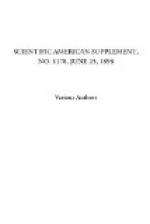These rods are held in place by a massive framework of iron and are turned to the left or to the right by means of a small steam engine, placed at one side of the lock, which engine, by means of a longitudinal shaft, drives two cross shafts to which bevel wheels are attached. By this means the chamber is lowered and raised. The screw rods are so powerful that they sustain the entire weight of the lock chamber, and the pitch of the thread is such that spontaneous sliding or slipping is impossible, the chamber being, therefore, kept constantly in the desired position.
It is interesting to note that the hollow space in the screw rods is heated by steam during winter, thus preventing the formation of ice in the machinery.
During the eighties, locks for ships of 400 tons capacity were erected in England and France, at Anderton, Les Fontinettes and La Louviere. The lock at Henrichenburg, however, exceeds all its predecessors, not only in size, but also in security. At all events, the structure is a worthy memorial of the energy and genius of German engineers.—Illustrirte Zeitung.
* * * * *
Paper hanging by machine is the latest achievement, according to a German contemporary, says The Engineer. The arrangement used for this purpose is provided with a rod upon which the roll of paper is placed. A paste receptacle with a brushing arrangement is attached in such a manner that the paste is applied automatically on the back of the paper. The end of the wall paper is fixed at the bottom of the wall and the implement rises on the wall and only needs to be set by one workman. While the wall paper unrolls and, provided with paste, is held against the wall, an elastic roller follows on the outside, which presses it firmly to the wall. When the wall paper has reached the top, the workman pulls a cord, whereby it is cut off from the remainder on the roll.
* * * * *
THE AMERICAN “REGULAR.”
By the English correspondent of the London times on board the United states transport “Gussie.”
The “regular” of the United States is in many respects the least equipped foot soldier of my acquaintance. This was my reflection as I overhauled the kit of a private this morning on board the “Gussie.” There was not a single brush in his knapsack. I counted three in that of a Spanish foot soldier only a few weeks ago. The American knapsack is merely a canvas bag cut to the outward proportions of the European knapsack, but in practical features bearing affinity with the “rueckensack” of the Tyrolean chamois hunters, or pack-sack of the backwoodsmen of Canada and the Adirondack Mountains. This knapsack of the American is not intended to be carried on any extended marches, although the total weight he is ever called upon to




